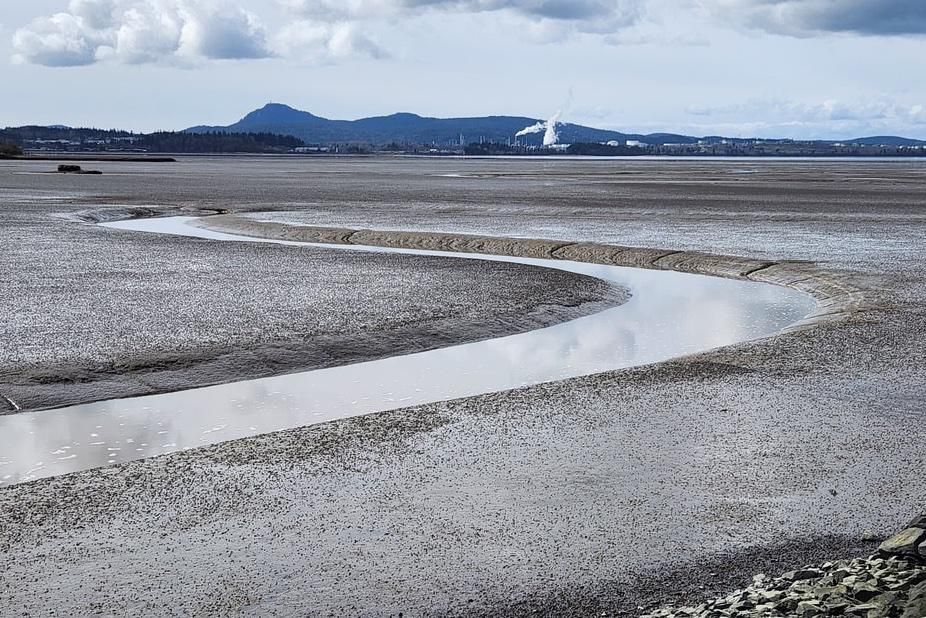It started as a simple walk that turned into a shocking awareness of an invasion occurring in our presence, a diverse local environment being turned into a monoculture desert.
After several days of gray and wet, Kath and I found a two-hour window of non-rain, of less-than-gray clouds, of little wind, and almost warmth. The parking lot at the south end of the Padilla Bay Shore Trail had room for one more car. We gratefully took it.
And truly it was windless and warm. Expecting the cold temperatures of the past week, we had overdressed with puffies and parkas. After a quarter mile, the parkas were in our packs. After a half mile, the puffies were off too, and soon I was down to just a long-sleeved shirt. The dike trail was warm, abuzz with insects, and songbirds serenading us as we walked along. The joy of spring filled the air with exuberance! The tide was low, approaching zero feet. Padilla Bay was nothing but mud and shallow channels here; green-winged teals dug into the surface industriously.
Getting to the halfway point, the muddy channels gave way to the wide-open flats of Padilla Bay itself. Offshore, the expansive blue water was a flat mirror of the sky all the way to Lummi and beyond.
I have walked this trail a dozen times or more, but usually at higher tides. This time, with mudflats extending a couple of miles, an invasion was obvious. Virtually every square inch of the mud had a bump of some kind. I had to see what this was. I clambered down the dike wall to the mud and saw what caused a million bumps on the sea bed: corkscrew-shaped snails, about two inches long. If you were to walk on the mud, you would crunch a dozen or more with each step. And the bumps of snails stretched as far as I could see, out to sea.
I found a dead snail shell and tucked it in my pocket. I walked the rest of the way to the north end, where Kath met me with the car. But instead of driving back home, I suggested we go to the Padilla Bay Interpretive Center just up the road.
Two friendly folks behind the counter greeted us. I pulled the snail shell from my pocket and asked "What is it?" They nodded their heads knowingly. “Yes, the mud snail,” one of them said sadly. I said there must be a million of them. They said it’s more like 15 billion. That’s with a B. And that’s just in Padilla Bay.
She explained that the Japanese mud snail arrived on the West Coast in the 1920s after hitchhiking on Pacific oysters transported from Japan to save the Puget Sound native oyster industry, which was collapsing from pollution and overharvesting. The bay serves as a perfect habitat for Japanese oysters, and for these snails. And with no natural predators, the snail population exploded.
They feed on microscopic algae called diatoms, an important food source for native species such as crabs and birds. These intruders are not just consuming vital nutrients; they are also eroding the sediments of the tidal flats, with each snail acting like a tiny but relentless excavator.
As water temperatures rise, the metabolism of the snails increases, allowing them to reproduce at even higher rates. Their populations continue to multiply exponentially.
There is currently no eradication plan for the Japanese mud snails in Padilla Bay.
Still, the trail is a delight on a day like today, watching hawks float above the farm fields, herons fishing at the tideline, and greeting joggers, hikers, bicyclists, parents pushing youngsters in strollers, teenagers walking with their eyes glued to their phones, and oldsters like us amazed just to be alive and a part of the panoply of life and beauty. And a quiet invasion.
Directions
Trail Conditions: the dike gives a firm, flat, graveled ten-foot wide trail for over 2 miles each way, dry in nearly all kinds of weather, but expose to the elements, so come prepared for whatever those elements are.
Directions: From Highway 20 between Burlington and Anacortes, turn north at the La Conner--Whitney intersection (at the O'Donnell's restaurant) and drive north about a mile to the south parking lot, or find the lot at the north end of the trailhead in Bay View.
Mobility: Flat, firm, graveled, dry, free of obstructions other than getting from the parking lot to the trail, which can be done.
Republished with permission. Read the original article.
